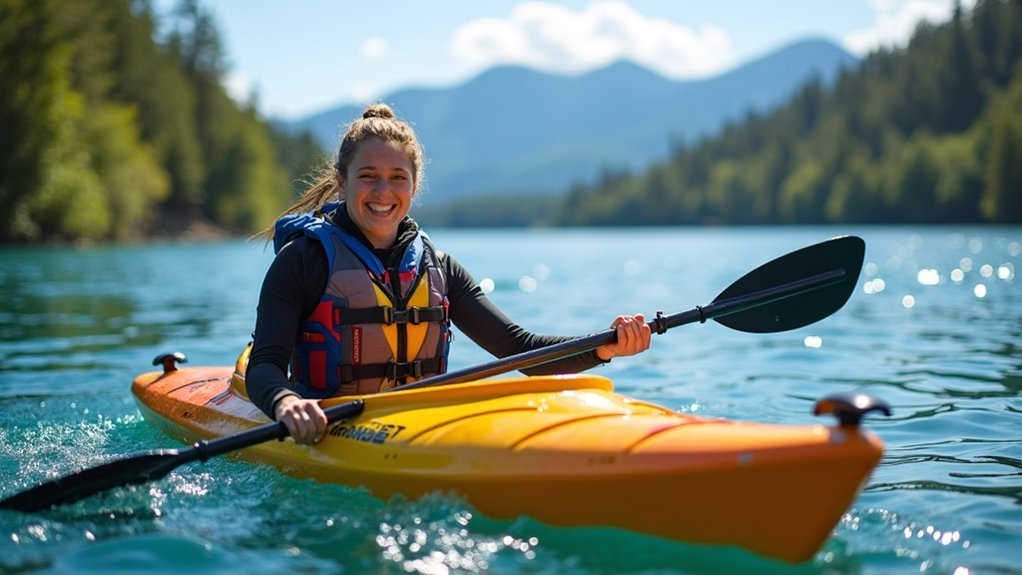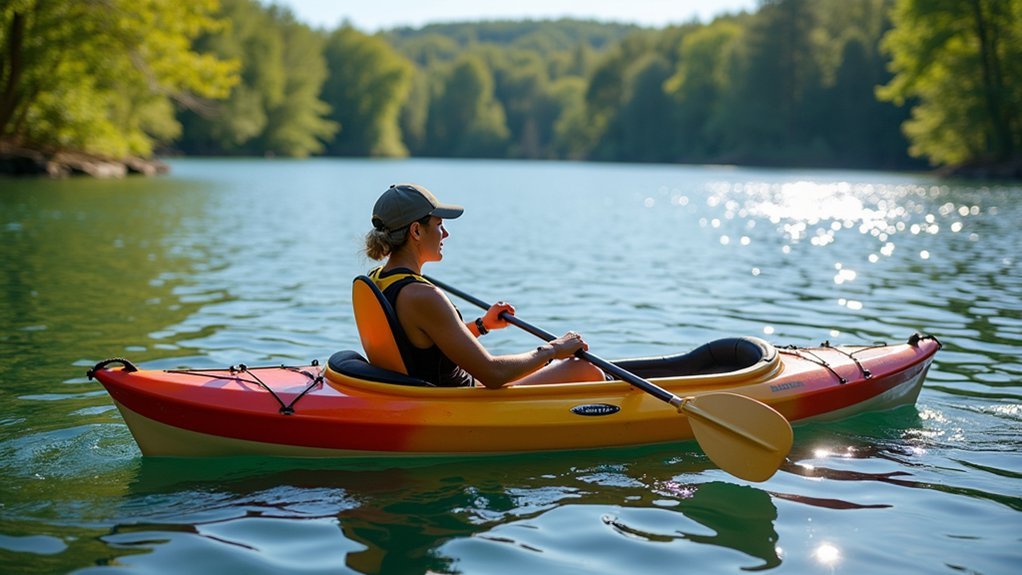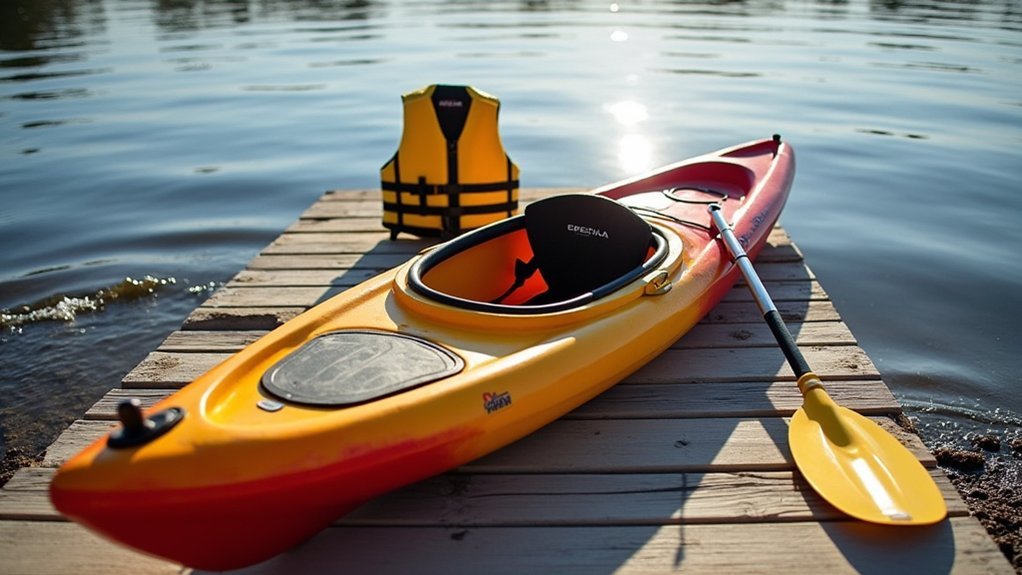The three most essential kayaking aids for disabled paddlers include adaptive paddle systems like the Gamut Paddle Holder ($315) that reduce joint stress, specialized kayak stabilizers or outriggers that prevent tipping, and ergonomic seating solutions with gel cushions to eliminate pressure points. These innovations transform the paddling experience from challenging to accessible, allowing you to enjoy the water independently. Discover how these adaptive technologies can specifically address your unique mobility needs and enhance your paddling adventures.
Adaptive Paddle Systems for Enhanced Support and Control

While traditional paddle designs work well for most kayakers, those with mobility challenges or joint limitations often need specialized equipment to enjoy time on the water.
The Gamut Paddle Holder System ($315.00) and Versa Paddle System ($375.00) utilize patented designs that greatly reduce joint stress and support paddle weight—perfect if you’re dealing with mobility limitations.
These adaptive paddle systems feature innovative rotary forearm movements that mimic pedaling motions, improving your efficiency and comfort, especially during windy conditions.
You’ll appreciate the customizable hand and wrist adaptations that enhance grip and control, addressing your unique needs as an adaptive paddler.
For those with limited mobility who dream of kayaking independently, these systems provide the support necessary to navigate waterways with greater confidence and less fatigue, opening up paddling possibilities that might otherwise remain inaccessible.
Specialized Kayak Stabilizers for Improved Balance and Safety
Maintaining control in your kayak goes beyond effective paddle systems—physical stability forms the foundation of safe and enjoyable paddling experiences.
Specialized kayak stabilizers, like Outriggers, provide essential support for adaptive paddlers with limited mobility, markedly reducing tipping risks while enhancing confidence on the water.
Outriggers deliver vital stability support, transforming the kayaking experience for adaptive paddlers by minimizing capsize dangers.
You’ll find these stability aids particularly valuable if you’re managing paralysis or spinal cord injuries, as they make entering and exiting your kayak much safer.
Kayak Stabilizing Floats work with both sit-on-top and sit-inside models, accommodating various mobility needs while minimizing fatigue during your paddling experience.
For maximum safety and performance, guarantee proper installation of your stabilizers.
They’ll support you effectively in challenging conditions like choppy waters without compromising your kayak’s maneuverability—keeping your adventures both accessible and enjoyable.
Ergonomic Seating and Transfer Solutions for Comfortable Paddling

Comfort serves as the cornerstone of accessible kayaking, especially when physical disabilities demand extended periods in a seated position. Ergonomic seating systems featuring gel or inflatable options eliminate pressure points that could otherwise limit your time on water.
Custom seat cushions paired with adjustable footrests guarantee proper alignment and support throughout your adaptive kayaking experience.
For paddlers with mobility limitations, accessing your kayak becomes simpler with specialized equipment:
- Transfer benches provide stable surfaces for safe entry and exit
- Sling systems assist with confident cockpit transfers while promoting independence
- Specialized adaptive seats deliver essential support for varying physical needs
- Gel cushions distribute weight evenly, preventing discomfort during extended paddles
These solutions transform kayaking from challenging to accessible, allowing you to focus on enjoying the water rather than managing discomfort.
Frequently Asked Questions
How to Make Kayaking More Accessible?
You’ll make kayaking more accessible by using adaptive equipment like sit-on-top kayaks, transfer benches, and outriggers. Don’t forget customized seating options and connecting with community programs that offer specialized training and support.
What Are the Three Golden Rules of Kayaking?
Always wear a properly fitted PFD. Keep a low center of gravity and maintain proper posture for stability. Stay aware of weather conditions and water currents to guarantee your safety while kayaking.
Do Expensive Kayak Paddles Make a Difference?
Yes, expensive paddles make a significant difference. You’ll notice reduced weight, better ergonomics, and less fatigue during long sessions. Carbon fiber options give you superior performance and comfort that’s worth the investment.
What Is Adaptive Kayaking?
Adaptive kayaking is how you’ll enjoy paddling despite physical disabilities. It includes modified equipment like specialized kayaks, customized paddles, and stability aids that let you participate independently and safely on the water.
In Summary
With these adaptive paddle systems, specialized stabilizers, and ergonomic seating solutions, you’re now equipped to enjoy kayaking regardless of your abilities. You’ll find paddling more accessible, comfortable, and safe as these aids compensate for mobility challenges while maximizing your independence on the water. Don’t let disability limit your adventure – these innovations guarantee you’re making the most of every paddling experience with confidence and freedom.





Leave a Reply